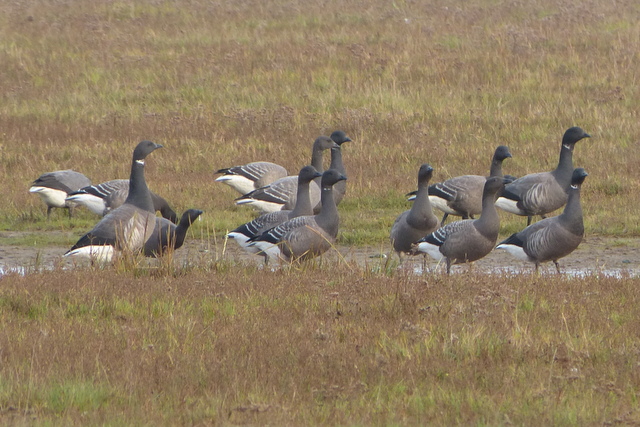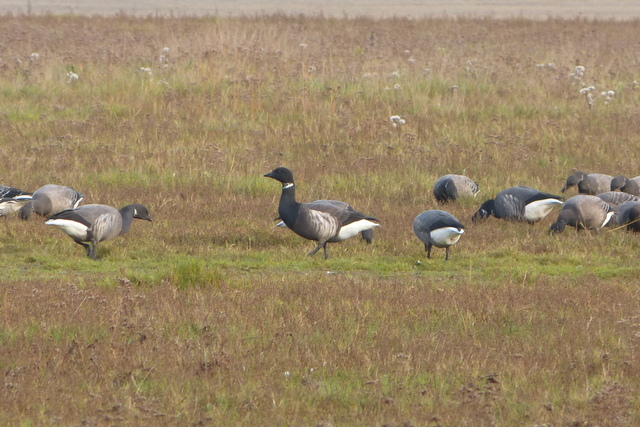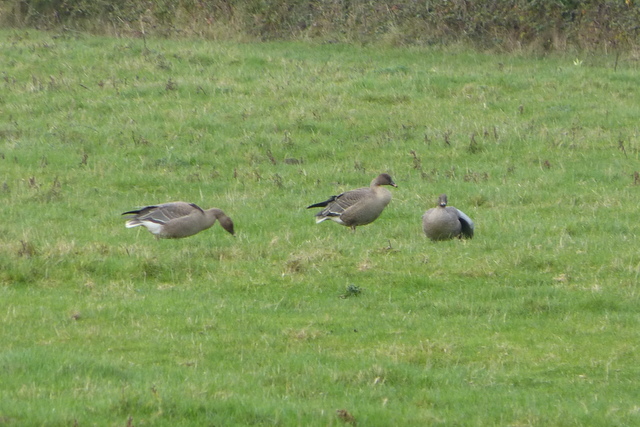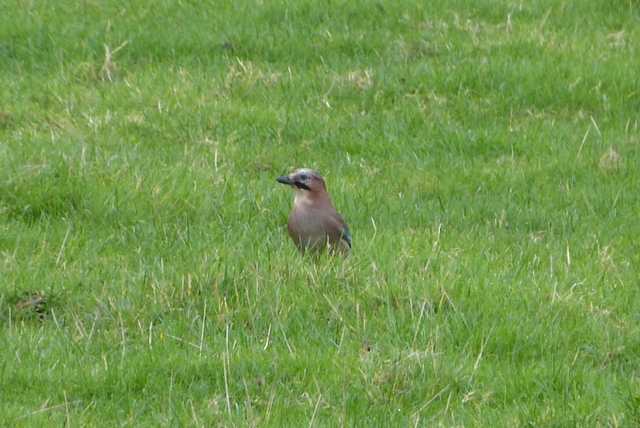Day 1 of a 3 day tour today. With the number of birds at Holkham recently, this seemed like a great place to start – to try to get some of the local specialities and lingering rarities in the bag.
No sooner had we arrived at Lady Anne’s Drive than a large flock of ducks and geese erupted from the grazing marsh. It might have been expected to have been due to one of the local Marsh Harriers which are ever-present here, but a quick look revealed it actually to be a ringtail Hen Harrier, a real treat. We watched it as it flew towards us, across Lady Anne’s Drive and away to the east. A Marsh Harrier duly followed behind shortly afterwards.
 Hen Harrier – over the grazing marsh this morning
Hen Harrier – over the grazing marsh this morning
With the weather this morning proving to be surprisingly bright, we decided to head out to the beach first thing to scan the bay. On our way out, there were lots of Skylarks and we stopped to watch a small group feeding on the edge of the dunes. A small flock of Brent Geese flew in and landed on the saltmarsh. Once again it was pleasing to see a nice proportion of stripy-backed juveniles amongst them, and to watch the various family squabbles as they fed.
 Brent Geese – lots of stripy juveniles were in the flock on the saltmarsh
Brent Geese – lots of stripy juveniles were in the flock on the saltmarsh
Scanning through this group, one bird stood out. It was subtly darker, slightly more blackish on the back and belly than the other Brents – our regular wintering birds are from Russia, of the ‘Dark-bellied’ bernicla race. Its white flank patch was more obvious and contrasting and the white collar more striking. We get occasional birds, so-called Black Brants from North America and East Siberia (of the race nigricans), amongst the wintering Brents here, but these are even blacker with more solid and brighter flanks and collars. Our bird was actually a hybrid Black Brant x Dark-bellied Brent, a returning bird and the product of a lost Black Brant from some years before which had paired and subsequently bred with one of our Brents. It was great to see it again and a very interesting and instructive bird for the group.
 Black Brant x Dark-bellied Brent hybrid – lurking amongst the Brents
Black Brant x Dark-bellied Brent hybrid – lurking amongst the Brents
Out on the beach, we scanned the bay for ducks, grebes and divers. There are lots of Common Scoters now gathered offshore and it didn’t take us long to pick up several Velvet Scoters in amongst them, including several very smart drakes. There is also a good number of Great Crested Grebes in the bay and several were diving just off the beach. Suddenly a much smaller grebe appeared amongst them – a winter-plumaged Slavonian Grebe. Being so close inshore, we got a great view of it and it was particularly good to be able to compare it to the much larger Great Cresteds. The Red-throated Divers were not quite so accommodating, and kept diving!
Looking out to sea, we could see a steady trickle of Blackbirds and thrushes flying in from Scandinavia, in ones and twos. Suddenly a Peregrine appeared, flying fast low over the waves. Following it, we could see that it was after a Blackbird which was struggling in low over the water. Then a second Peregrine appeared and the two of them took turns to swoop down at the poor bird. Somehow it made it to the beach, but there the falcons would surely be able to catch it as it would have to cross the vast open expanse of sand? At one point, they forced it down into a pool but miraculously it took off again and, jinking out of the way of the harrying Peregrines it dived into the dunes. Quite an amazing thing to watch!
At first we couldn’t locate the North American Surf Scoter which has been hanging out with the local Velvet Scoters for some weeks now. However, a timely phone call alerted us to its presence further up the beach. A quick walk along and we could see the bird slightly distantly offshore. Thankfully the group it was with took off and flew towards us – we got a great view of the Surf Scoter as it came past. It was also good to see the Velvet Scoters in flight, showing the diagnostic white trailing edge to their inner wings. A Scaup was also hiding in with them, but we couldn’t find it as the flock landed again on the sea. Having enjoyed the ducks, we had a quick walk along the beach to see if we could locate any Snow Buntings, but by now it was rather too disturbed with dog walkers, so we headed back to the car for lunch.
 Pink-footed Geese – a small group were close to Lady Anne’s Drive
Pink-footed Geese – a small group were close to Lady Anne’s Drive
In the afternoon, we headed west on the inland side of the pines. There were a few Pink-footed Geese in the fields by Lady Anne’s Drive as we set off which we got a closer look at. At Salts Hole, we stopped to look at the Little Grebes and a pair of Wigeon out on the water. There were large flocks of Wigeon out on the grazing marsh and the walk was accompanied by their incessant whistling, as well as the high-pitched honking of more Pink-footed Geese which were starting to gather on the marshes. On the edge of the pines, we paused to watch several Goldcrests and a Treecreeper. We encountered several mixed tit flocks and heard a couple of lingering Chiffchaffs.
At the western end of the pines, we stood for a while and scanned over the grazing marshes. There was a good selection of raptors on view – several Marsh Harriers, a couple of Common Buzzards, Kestrels and a Sparrowhawk. We walked a bit further and climbed up into the dunes to get a better view and finally the Rough-legged Buzzard appeared, initially flying off and disappearing into the dunes before returning a short while later. We watched it for some time, hunting out over the grazing marsh and hovering repeatedly, occasionally landing on the ground.
From our position in the dunes, we also got a great view of the bushes on the inland side, which were now alive with recently arrived thrushes, those that had escaped the trials of marauding Peregrines and gulls offshore. There were lots of Blackbirds, together with a few Redwings, plus a couple of Fieldfare and Song Thrush. A scan through the groups of Pink-footed and Brent Geese on the marshes revealed a couple of Barnacle Geese amongst them.
With the light starting to go, we headed back. Many more Blackbirds and thrushes were looking to go to roost in the bushes by the track. Large flocks of Pink-footed Geese were continuing to arrive in the gloom and the cacophony of noise suggested a significant gathering out on the marshes. Finally a Barn Owl flashed out in front of us. Fortunately, we got back to the car just before the rain started.

















